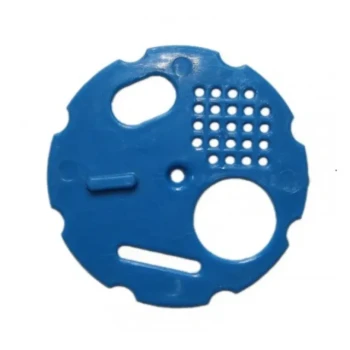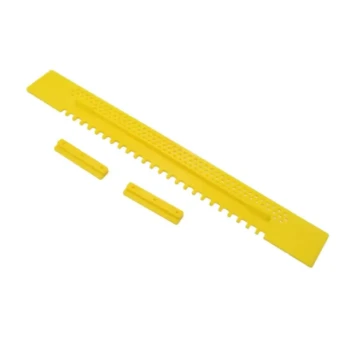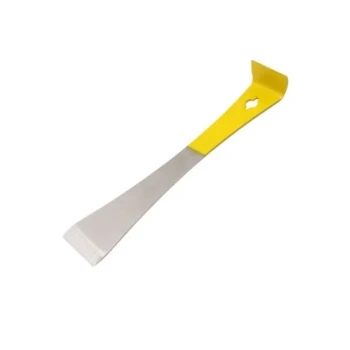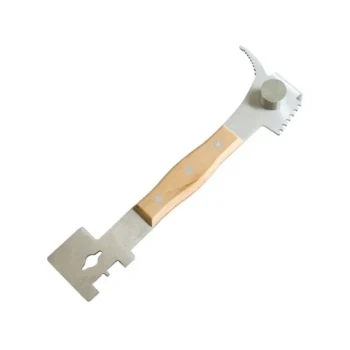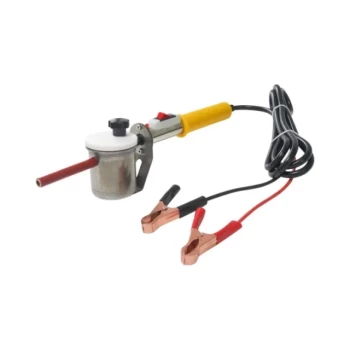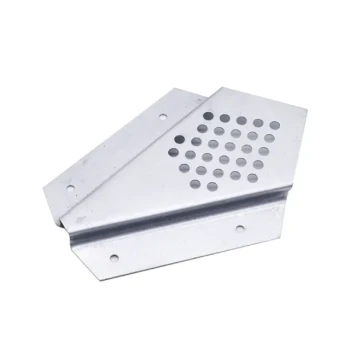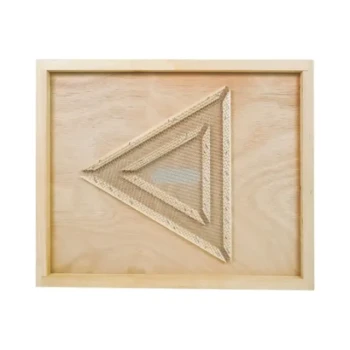The standard recommendation for a top-bar hive entrance is a series of five to seven holes, each 3/4 inch in diameter, drilled at one end of the hive body. At least one of these holes should be flush with the hive's bottom to allow bees to easily remove debris. The key is that these entrances are not static; you will open and close them throughout the year to manage the colony's needs.
The most effective top-bar hive entrance is not a single feature but a dynamic system. Using multiple small, adjustable holes gives you precise control over ventilation, temperature, and hive security, allowing you to adapt to the colony's changing strength and seasons.

The Principles of Top-Bar Hive Entrances
A top-bar hive entrance is designed to mimic the small openings bees would naturally choose in a tree hollow. This approach prioritizes defensibility and environmental control over a single, large opening.
Why Multiple Small Holes?
Unlike the single, wide entrance of a Langstroth hive, multiple small holes are easier for guard bees to defend. A smaller colony can effectively protect one or two small openings from pests like wasps or robbing bees from other hives.
This setup also gives the beekeeper granular control. You can precisely match the entrance size to the colony's population and the current nectar flow, preventing traffic jams without compromising security.
The Standard Recommendation: Size and Placement
A 3/4-inch diameter is the most common size for entrance holes. This is large enough for bees, even those laden with pollen, to pass through easily but small enough to be manageable for guards.
These holes should be drilled in a cluster at one end of the hive. This encourages the bees to build their brood nest near the entrance and store honey further away, creating a logical and predictable hive structure.
The Importance of a "Housekeeping" Hole
Placing at least one entrance hole flush with the bottom board is critical. Bees are meticulous housekeepers, and this lower exit provides them with a convenient way to carry out dead bees, debris, and other waste, keeping the hive clean and healthy.
Managing Your Entrance Through the Seasons
The primary advantage of multiple entrances is the ability to adapt. Your management of these holes will change significantly depending on the time of year and the strength of your colony.
Spring Build-Up
As the queen begins laying and the colony's population expands, you can open a second or third hole. This accommodates the increasing number of foragers leaving and returning to the hive.
Summer Nectar Flow
During the peak of summer, a strong colony will be extremely active. Opening most or all of the entrances prevents traffic jams at the front door. This increased airflow also provides crucial ventilation, helping the bees cool the hive.
Late Summer and Fall (Robbing Season)
As nectar sources dwindle, the risk of robbing from other hives and wasps increases. This is the time to reduce the number of open holes. A smaller, more defensible entrance helps the colony protect its vital winter honey stores.
Winter Clustering
In winter, the colony's goal is to conserve heat. Reduce the entrance down to a single, small hole. This minimizes heat loss while still allowing for necessary cleansing flights on warmer days. Many beekeepers use corks or wooden plugs to easily close the unused holes.
Understanding the Trade-offs
Every design choice in beekeeping involves balancing competing factors. The hive entrance is a perfect example of this principle.
Too Large: The Risk of Pests and Robbing
An entrance that is too large for the colony to defend is an open invitation to trouble. A weak colony with a wide-open entrance is highly vulnerable to being robbed of its honey, which can lead to the colony's collapse. It also makes it easier for pests like mice to enter during the winter.
Too Small: The Bottleneck Problem
Conversely, an overly restricted entrance can be just as harmful. It creates a bottleneck for foraging bees, reducing the amount of nectar and pollen coming into the hive. Insufficient ventilation from a small entrance can also lead to overheating and excess humidity in the summer.
Making the Right Choice for Your Colony
Ultimately, the entrance should serve the specific needs of your bees at any given time. Observing your hive is the best way to determine the correct configuration.
- If your primary focus is establishing a new, small colony: Keep the entrance reduced to one or two holes to make defense easy and help them feel secure.
- If your primary focus is supporting a large, booming colony in summer: Open all available entrances to maximize foraging efficiency and provide critical ventilation.
- If your primary focus is preparing for winter or a nectar dearth: Reduce the entrance to a single small opening to help the colony conserve heat and defend its resources.
Properly managing the hive entrance is one of the most powerful and simple tools a top-bar beekeeper has to ensure a healthy, productive, and resilient colony.
Summary Table:
| Aspect | Standard Recommendation |
|---|---|
| Number of Holes | 5 to 7 holes |
| Hole Diameter | 3/4 inch |
| Placement | Clustered at one end of the hive body |
| Key Feature | At least one hole flush with the bottom board for debris removal |
Ready to build or optimize your top-bar hive? Equip your apiary with the right supplies for success. HONESTBEE supplies durable, well-designed beekeeping equipment to commercial apiaries and distributors through our wholesale-focused operations. Let us help you create a thriving, manageable hive system. Contact our wholesale team today to discuss your needs!
Visual Guide
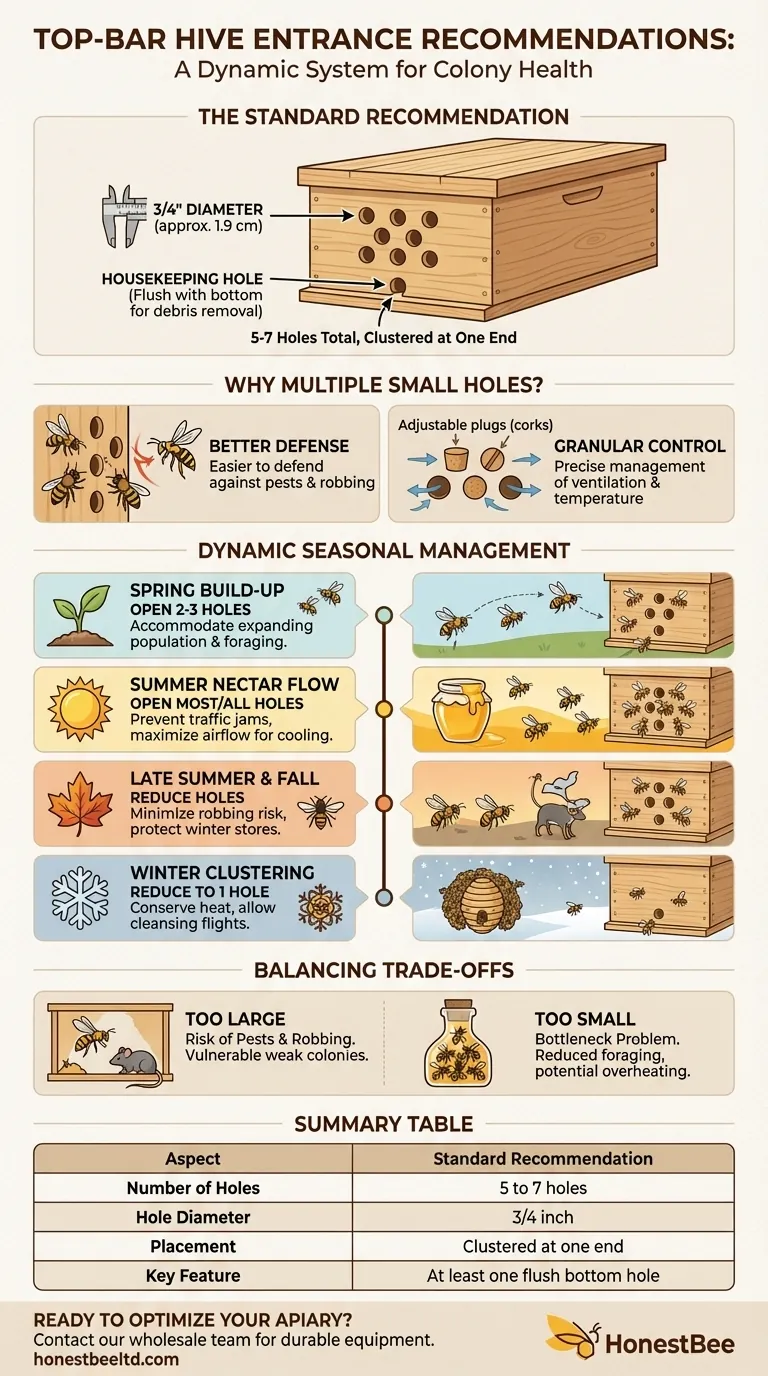
Related Products
- Beehive Entrance Reducer Guardian Metal Hive Entrance for Bees
- Multi-Functional Sliding Hive Entrance for Beekeeping
- Multi-Functional Rotary Hive Entrance Disc for Beekeeping
- Professional Reversible Beehive Hive Entrance
- Beehive Entrance Discs Plastic Bee Entrance Disc for Bee Hives
People Also Ask
- What are the different entrance sizes for an 8 or 10-frame Langstroth hive? A Guide to Seasonal Management
- How big should a beehive entrance be? Optimize for Colony Health & Honey Production
- What are the two functions of the Entrance Reducer? Master Hive Defense and Safe Transport
- What size is the entrance hole in a native bee hive? The 13mm Standard for a Thriving Colony
- How can a Langstroth hive entrance be adjusted? Mimic Natural Bee Preferences for a Healthier Hive


